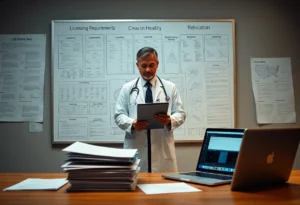Just when you think you have everything under control, relocating your medical staff can feel overwhelming. However, with the right strategies, you can streamline the process and minimize stress for both you and your team. In this guide, you’ll discover practical steps to ensure a seamless transition, from planning logistics to fostering a supportive team environment. Let’s look into how you can tackle this move efficiently and effectively, making it a positive experience for everyone involved.
Crafting a Pre-Move Checklist: Essential Steps to Organize Your Move
A well-crafted pre-move checklist can significantly enhance your medical staff relocation experience. Start by breaking down tasks into manageable parts, ensuring that no detail gets overlooked. Organize the list according to categories such as packing, logistics, and settling in. This approach not only provides clarity but also helps you track progress, turning a daunting task into a streamlined process that keeps everything on schedule.
Key Elements to Include in Your Checklist
Your checklist should encompass a variety of important elements, including but not limited to: updating contact information, booking moving services, inventorying medical equipment, and ensuring compliance with local regulations. Additionally, consider adding tasks related to personal transitions, such as securing housing and exploring local amenities. Incorporating these parts ensures a comprehensive approach to your move.
Useful Tools and Apps for Checklist Management
Utilizing the right tools can elevate your checklist management experience tremendously. Apps like Trello and Todoist allow for creating customizable to-do lists, offering reminders and organizational features. You can also explore Google Keep for quick notes and checklists that sync across devices, making it easy to keep everything at your fingertips. Such tools enhance collaboration if you’re part of a larger moving team.
Adopting these management tools can transform how you approach your moving checklist. For instance, Trello’s card system allows you to visualize each task as a separate entity, enabling team members to take ownership of specific categories. This means you can assign tasks like contacting the moving company or arranging for specialized medical equipment transport. With real-time updates, your entire team can stay informed and connected, reducing the stress typically associated with relocations.
Navigating Logistics: Coordinating the Move with Precision
Managing the logistics of a medical staff relocation requires careful consideration and meticulous planning to ensure a smooth transition. Begin by mapping out key timelines and responsibilities to keep the move organized and on track. You can leverage technology to create a detailed checklist and timeline, streamlining communication among team members. Anticipate potential challenges by conducting pre-move assessments of both the new and old locations. This thorough approach not only diminishes stress but also fosters a sense of teamwork among your staff, paving the way for a successful relocation.
Selecting the Right Movers: What to Look For
Choosing the right moving company can significantly impact your relocation experience. Look for movers with experience in medical facility relocations, as they understand the unique requirements of transporting sensitive equipment and handling compliance regulations. Verify their credentials, including licenses and insurance, to ensure reliability. Reading reviews and requesting references can also provide insights into their past performance, enabling you to feel confident in your choice.
Timing Your Move: Best Practices for Seamless Transitions
Establishing an optimal moving schedule enhances the overall efficiency of your relocation. Aiming for off-peak days can help minimize service disruptions and facilitate easier access for moving crews. Plan the move during periods when patient volume is lower, such as weekends or holidays, allowing staff to focus on logistics without affecting patient care. Additionally, aim to have all preparations finalized at least four weeks in advance, so that unexpected issues can be addressed proactively.
To refine the timing of your move, create a phased timeline that includes pre-move logistics, moving day preparations, and post-move follow-ups. Coordinate with your team to ensure everyone is aware of their roles and deadlines. Consider conducting a trial run by relocating smaller equipment or supplies first; this allows your staff to identify potential challenges without impacting daily operations. Scheduling regular check-ins leading up to the move will keep everyone aligned and informed, ultimately streamlining the entire process.

Maintaining a Positive Atmosphere: Boosting Morale During the Move
Creating a positive atmosphere during the relocation of your medical staff can significantly impact their morale and overall experience. Organizing team-building activities, celebrating small victories, and sharing success stories throughout the move can foster camaraderie. Encourage open communication and be present to address any concerns, ensuring that everyone feels supported. Maintaining transparency about changes helps build trust and can reduce anxiety as your team transitions into a new environment.
Communicating Effectively with Your Staff
Effective communication is paramount to ensuring that your staff feels informed and valued throughout the relocation process. Regular updates can help mitigate uncertainty; consider utilizing emails, meetings, or dedicated communication platforms to articulate timelines, expectations, and any changes that may arise. Opening channels for feedback allows your team to voice their concerns, fostering an inclusive environment that reinforces their role during the transition.
Creating a Relocation Support System: Resources and Contacts
A comprehensive relocation support system is imperative for easing the process for your medical staff. Compile a list of local services—like moving companies, temporary housing, childcare services, and community organizations—that can assist during the transition. Providing contact information for these resources enables your staff to access support readily and helps them settle more comfortably into their new community.
Offering a centralized resource hub, whether through an online platform or a printed manual, can be invaluable. Make this hub easily accessible, containing contacts for moving assistance, health services, and local establishments. You might also include information on support groups or personnel who can answer relocation-related questions. Having tangible resources at their fingertips reassures your team and allows them to focus on their work and the transition, further enhancing morale.
Settling In: Making the New Location Feel Like Home
Transitioning to a new location can feel overwhelming, but personalizing your workspace and environment can significantly ease the process. Start by adding items that bring you comfort, such as family photos, artwork, or plants. Creating a space that reflects your personality fosters a sense of belonging, ultimately making you feel at home in your new surroundings.
Tips for Creating a Comfortable and Functional Workspace
To enhance your workspace, focus on elements that promote both comfort and efficiency. Consider the following:
- Invest in ergonomic furniture to support your posture.
- Organize your desk with organizers or drawers for easy access to supplies.
- Incorporate ambient lighting, such as desk lamps, to reduce eye strain.
- Add personal touches like inspirational quotes or favorite books.
After optimizing your workspace, you’ll find that a well-designed environment boosts productivity and morale.
Engaging Staff in the Community: Building Connections
Connecting with your new community is vital for establishing a supportive network. Foster relationships by participating in local events, joining professional organizations, or volunteering your skills to contribute positively to society.
Engaging with the community not only helps reduce feelings of isolation but also creates shared experiences that enhance camaraderie among staff. Look for opportunities such as local health fairs, charity events, or workshops that align with your interests and expertise. Organizing team outings can facilitate bonding, making it easier to adapt to the new environment together. By integrating into the community, you can enrich both your personal life and your professional network, leading to a more fulfilling relocation experience.
Overcoming Emotional Hurdles: Understanding the Psychological Impact of Relocation
Relocating can trigger a wave of emotions, from excitement about new opportunities to anxiety about leaving behind familiar surroundings. As a medical professional, you may face additional pressures, such as maintaining patient care while adjusting to a new environment. Recognizing these psychological impacts is necessary for smoothly navigating this transition. Allowing yourself to acknowledge and process your feelings is a vital first step toward overcoming the emotional hurdles of relocation.
Recognizing Common Stressors and Coping Strategies
Common stressors during relocation include fear of the unknown, social isolation, and the challenges of settling into a new routine. Developing effective coping strategies can mitigate these feelings. Techniques such as mindfulness, establishing a daily schedule, and engaging with local community groups can foster a sense of stability and connection. You might also find comfort in discussing your experiences with fellow medical staff who have gone through similar transitions.
Providing Support Resources: Counseling and Employee Assistance Programs
Access to counseling services and Employee Assistance Programs (EAP) can be a lifeline during your relocation. These resources offer confidential support, helping you navigate emotional challenges and adjust to your new setting. EAPs often provide free counseling sessions, workshops, and resources focused on stress management and well-being.
Leveraging counseling and Employee Assistance Programs allows you to process your emotional experience more effectively. For instance, many programs provide 24/7 hotlines and online resources to facilitate immediate access to professional help. Utilizing these services not only helps you cope with stress but also enhances your resilience in maintaining a healthy work-life balance. Bear in mind, having a supportive network, whether through professional services or peer connections, can significantly ease the transition and foster a sense of belonging in your new environment.
Final Words
To wrap up, ensuring a stress-free medical staff relocation experience involves thorough planning and open communication. By organizing logistics well in advance and maintaining regular contact with your team throughout the process, you can alleviate concerns and streamline transitions. Utilize resources and support from your institution to address any challenges that arise. With the right approach, you can create a smooth, efficient relocation that enables your staff to feel settled and focused on their important work.




